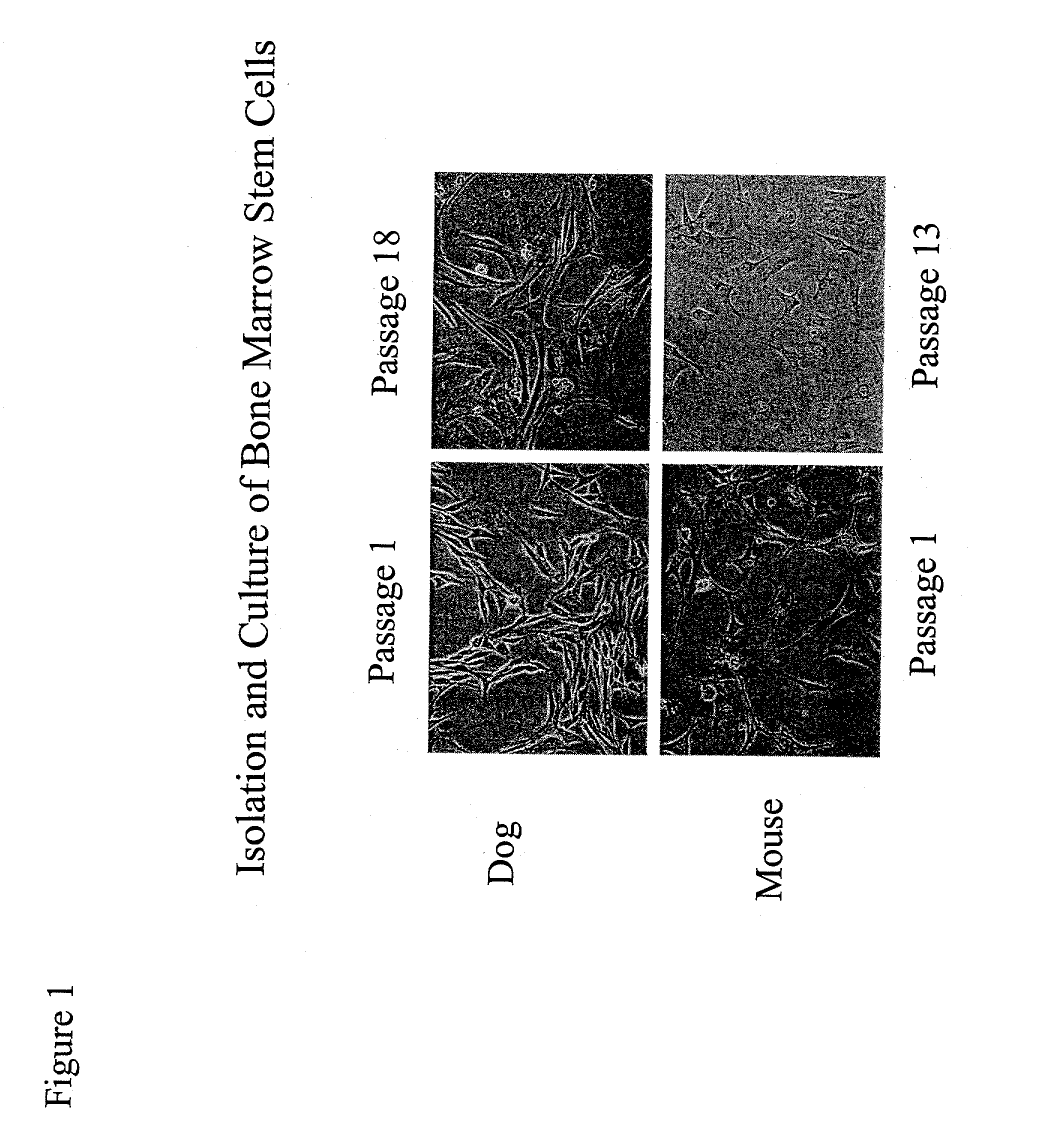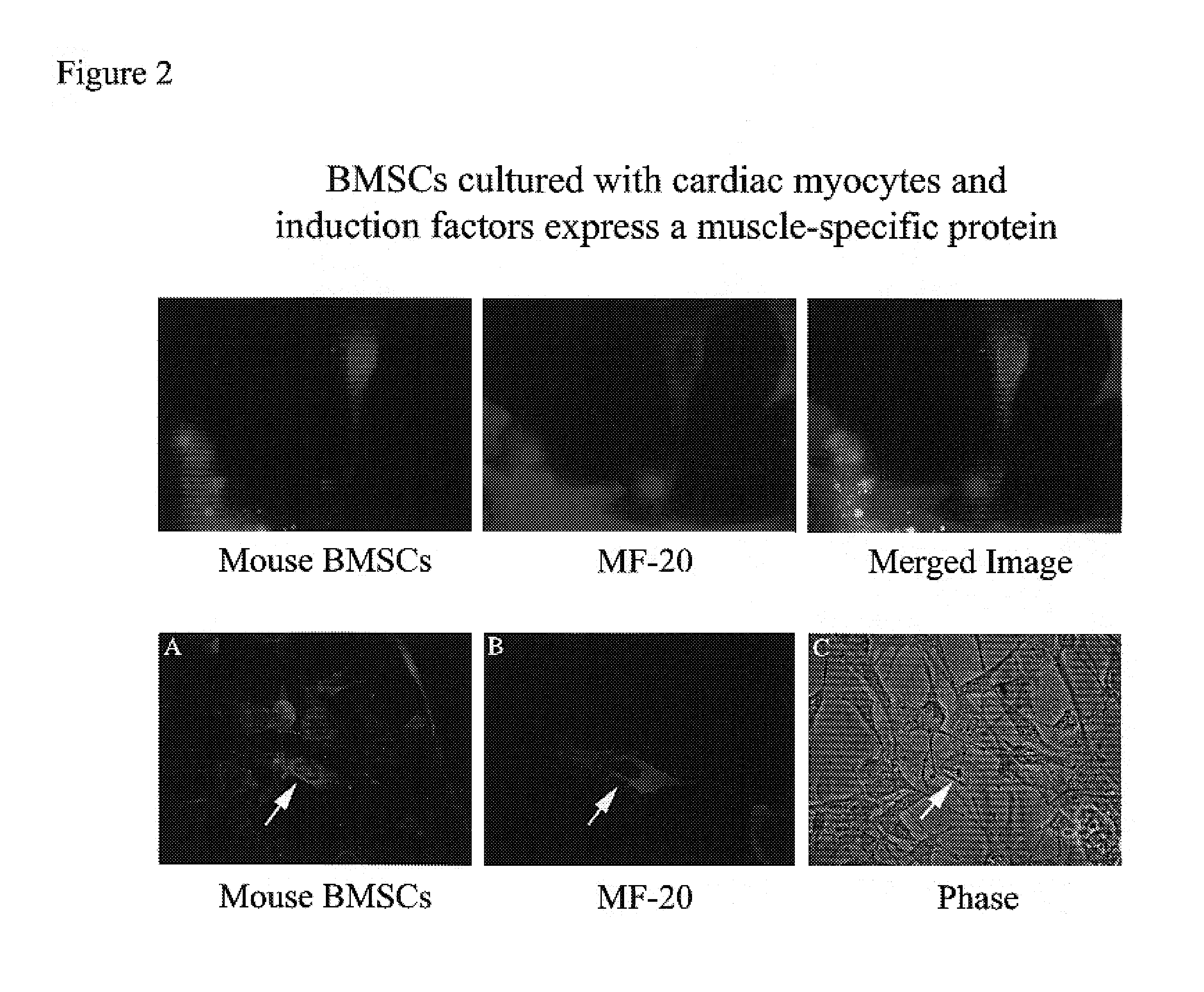Encapsulated cell indicator system
a cell indicator and cell technology, applied in the direction of genetically modified cells, non-embryonic pluripotent stem cells, skeletal/connective tissue cells, etc., can solve the problems of current cell transplantation methods for cardiac tissue that are clinically inadequate, and the rate of implant incorporation into the host tissue, so as to reduce or alleviate at least one adverse
- Summary
- Abstract
- Description
- Claims
- Application Information
AI Technical Summary
Benefits of technology
Problems solved by technology
Method used
Image
Examples
example 1
Induction of Cardiomyogenic Cells from BMSCs
[0073]Marrow was isolated from adult mouse and dog. The BMSCs were isolated and cultured in medium containing 10% fetal bovine serum, 100 μM L-ascorbic acid-2-PO4, 5-15 ng / ml leukemia inhibitory factor (LIF), and 20 nM dexamethasone (for mouse cultures, mouse LIF was used, while for dog cultures, human LIF was used). This in vitro condition allows the BMSCs to maintain their self-renewing character and to expand by passaging without losing responsiveness to the differentiation agents such as growth factors. Further, stem cells cultured through multiple passages maintain a mesenchymal morphology and karyotye (FIG. 1). After 14 days in culture with growth factors (50 ng / ml BMP2, 100 ng / ml bFGF), approximately 80% of the BMSCs were positively stained with Csx / Nkx2.5, MF-20 (a monoclonal antibody specific for sarcomeric myosin), and desmin antibodies, indicating that the cells had differentiated as cardiomyocytes (FIGS. 3 and 4).
[0074]To mimic...
example 2
BMSCs From Humans and Other Mammals
[0076]The foregoing example utilizes mouse BMSCs for illustrative purposes. Human BMSCs are also known in the art to be capable of producing cardiac cells (Pittenger et al., Science 284: 143-147, 1999). BMSCs from other mammals (e.g., humanized pig BMSCs) can also be used in the methods of the invention (Levy et al., Transplantation 69: 272-280, 2000).
example 3
Methods of Inducing BMSCs to Become Cardiomyogenic
[0077]As is described above, co-culturing BMSCs with cardiomyocytes in the presence of BMP2 and / or bFGF results in the induction of cardiomyogenic cells capable of differentiating as cardiomyocytes in culture. The ratio of BMSCs to inducer cells and the concentration of growth factor(s) can each be adjusted to modulate the rate and amount of cardiomyogenic cell induction. For example, the ratio of BMSCs to inducer cells can range from about 1:1 to about 1:1000 or more. The concentration of BMP2 can range from about 0.5 ng / ml to about 1 μg / ml, while the concentration of bFGF can range from about 1 ng / ml to about 5 μg / ml. It is understood that other BMP / TGFβ and FGF family members can be used instead of BMP2 and / or bFGF.
[0078]Other methods known to induce BMSCs to become cardiomyogenic cells can be used in the present invention. Not all methods that induce cardiomyocytes can be used in the invention. For example, 5-azacytidine is used ...
PUM
| Property | Measurement | Unit |
|---|---|---|
| Permeability | aaaaa | aaaaa |
| Fluorescence | aaaaa | aaaaa |
Abstract
Description
Claims
Application Information
 Login to View More
Login to View More - R&D
- Intellectual Property
- Life Sciences
- Materials
- Tech Scout
- Unparalleled Data Quality
- Higher Quality Content
- 60% Fewer Hallucinations
Browse by: Latest US Patents, China's latest patents, Technical Efficacy Thesaurus, Application Domain, Technology Topic, Popular Technical Reports.
© 2025 PatSnap. All rights reserved.Legal|Privacy policy|Modern Slavery Act Transparency Statement|Sitemap|About US| Contact US: help@patsnap.com



